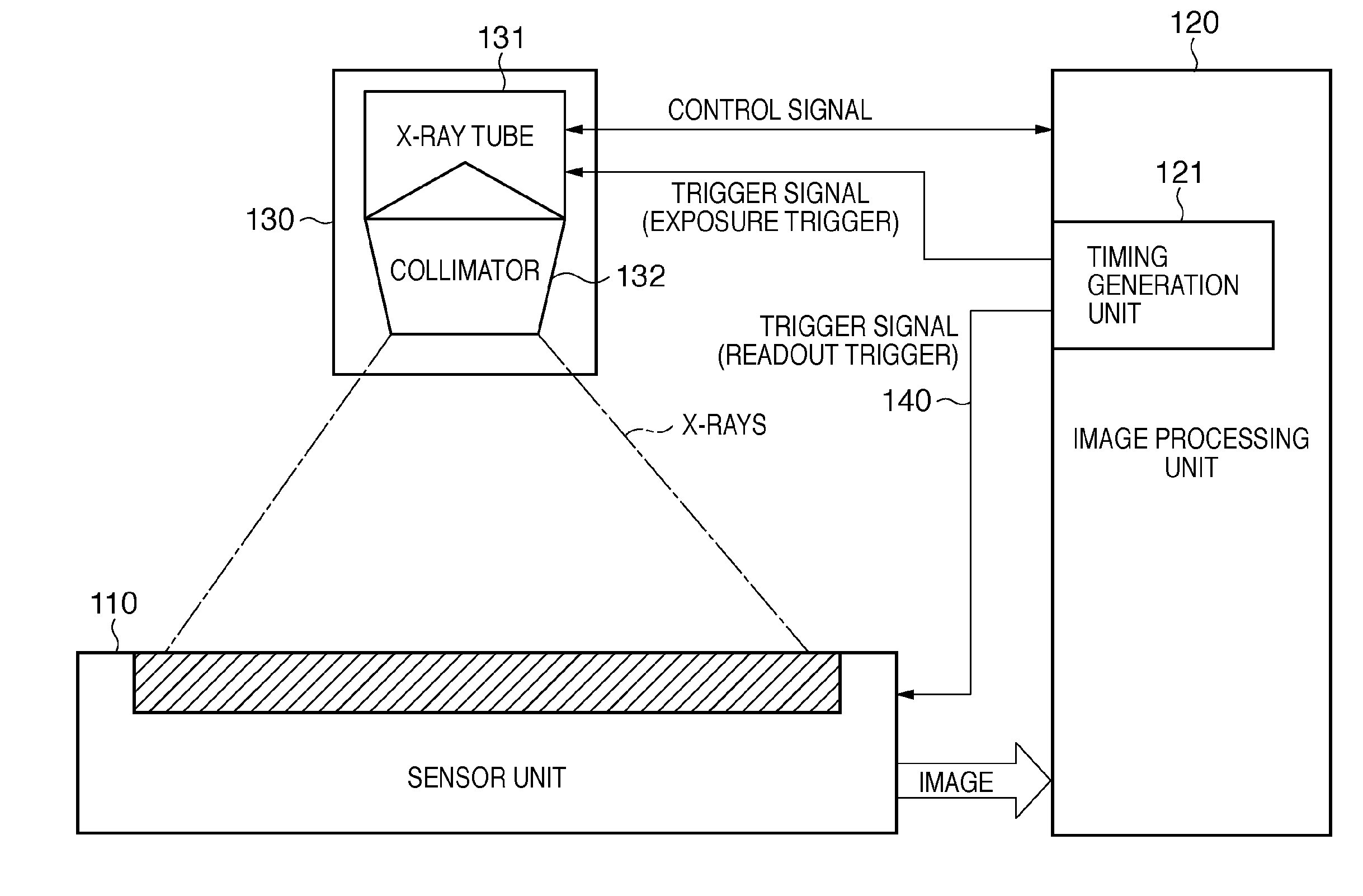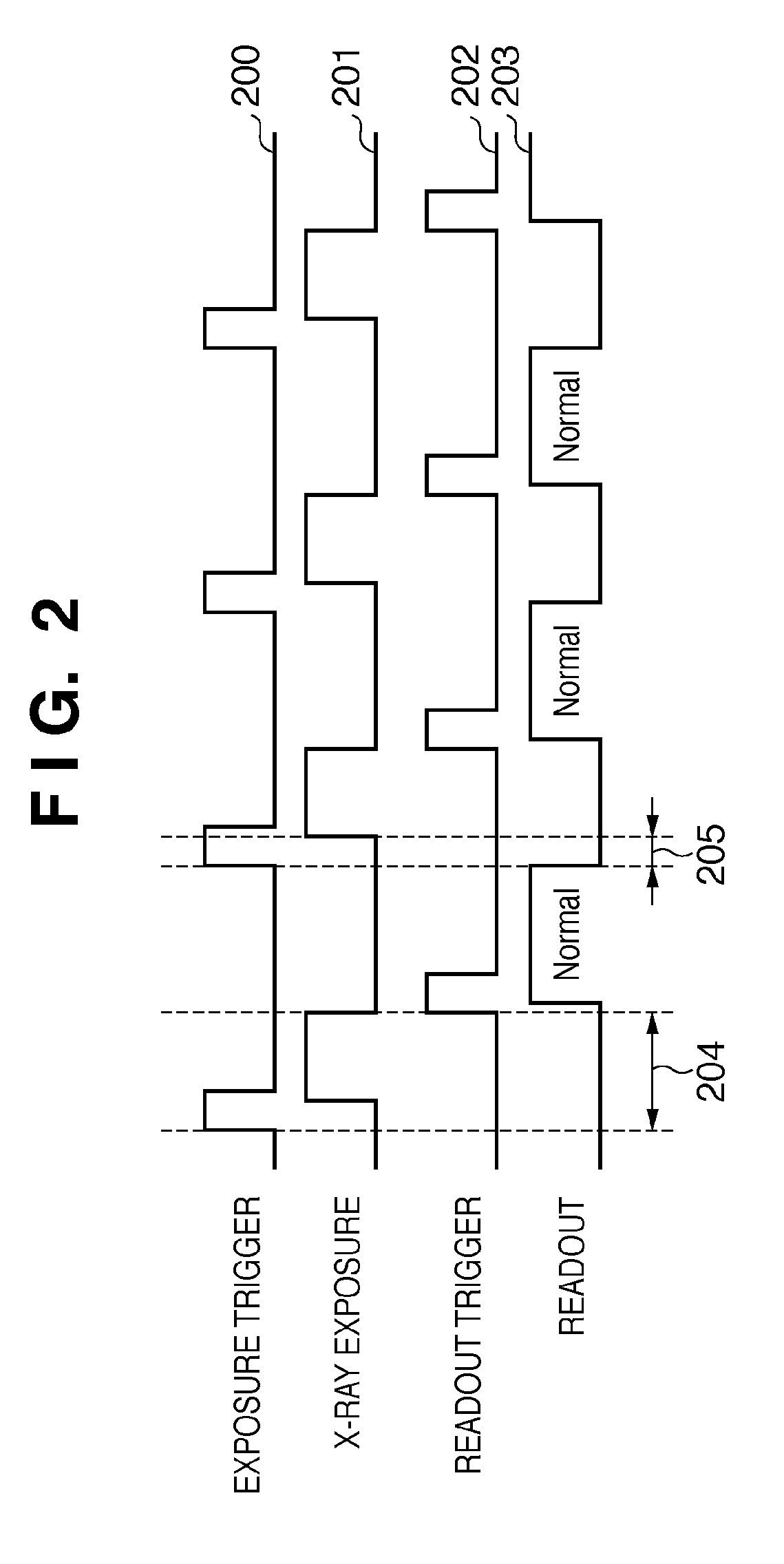Wireless x-ray fluoroscopic imaging system, inter-unit synchronization method of the same, and computer program
a fluoroscopic imaging and synchronization method technology, applied in the field of xray fluoroscopic imaging system, can solve the problems of difficult to establish synchronization, power supply and large-volume image data handling, and inability to read accurate image data ou
- Summary
- Abstract
- Description
- Claims
- Application Information
AI Technical Summary
Problems solved by technology
Method used
Image
Examples
first embodiment
[0047]An outline of this embodiment will be explained below with reference to FIG. 6. FIG. 6 is an example of a system block diagram for explaining the outline of the first embodiment of the present invention.
[0048]An X-ray fluoroscopic imaging system according to the present invention includes a sensor unit 610 physically separated from other units, and an image processing unit 620 including an X-ray generation unit 630 required operating in synchronism with the sensor unit 610.
[0049]The sensor unit 610 has a wireless communication unit A 611 and compare timer A 612. The compare time A 612 generates a readout trigger. This readout trigger initiates readout from the sensor.
[0050]The image processing unit 620 includes a wireless communication unit B 621, compare timer B 622, and timing generation unit 623. The compare timer B 622 generates an exposure trigger for an X-ray tube 631. This exposure trigger initiates X-ray exposure. The timing generation unit 623 generates a timing signa...
second embodiment
[0085]In the first embodiment, the method of synchronizing the timings of the wirelessly connected sensor unit and image processing unit by using the beacon signal synchronized with the frame cycle has been described. In the second embodiment, an application form of the present invention when performing angiography or the like by which fluoroscopic imaging is performed while changing the frame cycle will be described.
[0086]To explain an outline of this embodiment, the case where the first frame cycle is changed to the second frame cycle will be explained. Assume that fluoroscopic imaging is performed by the first readout trigger offset and first exposure trigger offset for use in the first frame cycle. The second readout trigger output and second exposure trigger offset for use in the second frame cycle are saved in a sensor unit 610 and image processing unit 620 beforehand. The first frame cycle is switched to the second frame cycle in response to the transmission of a beacon signa...
third embodiment
[0128]In each of the previous embodiments, the method of simply and accurately synchronizing the timings of the wirelessly connected sensor unit and image processing unit by using the beacon signal synchronized with the frame cycle has been described. In the third embodiment, a method of synchronizing the frame rate and beacon interval will be described.
[0129]Generally speaking, when matching the frame cycle with the beacon interval, it is sometimes impossible to freely select the beacon interval unless unique wireless communication standards are defined. As shown in FIG. 4, for example, the beacon interval of the IEEE802.15.3 (UWB) standards can be selected from only 512 to 65,535 μsec. When represented by the frame rate, this range is 1,953 fps (= 1 / 512 μsec) to 15.26 fps (= 1 / 65,535 μsec). Actual fluoroscopic imaging is generally performed at a frame rate of about 0.1 to 200 fps. Accordingly, the above frame rate cannot be applied to fluoroscopic imaging performed at a frame rate...
PUM
 Login to View More
Login to View More Abstract
Description
Claims
Application Information
 Login to View More
Login to View More - R&D
- Intellectual Property
- Life Sciences
- Materials
- Tech Scout
- Unparalleled Data Quality
- Higher Quality Content
- 60% Fewer Hallucinations
Browse by: Latest US Patents, China's latest patents, Technical Efficacy Thesaurus, Application Domain, Technology Topic, Popular Technical Reports.
© 2025 PatSnap. All rights reserved.Legal|Privacy policy|Modern Slavery Act Transparency Statement|Sitemap|About US| Contact US: help@patsnap.com



